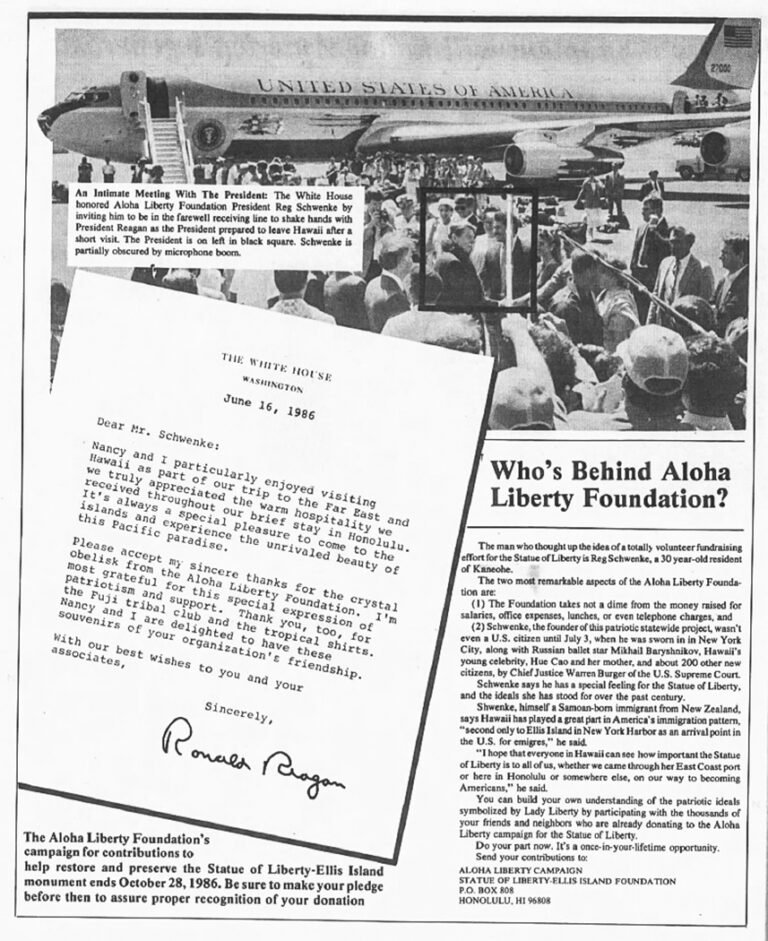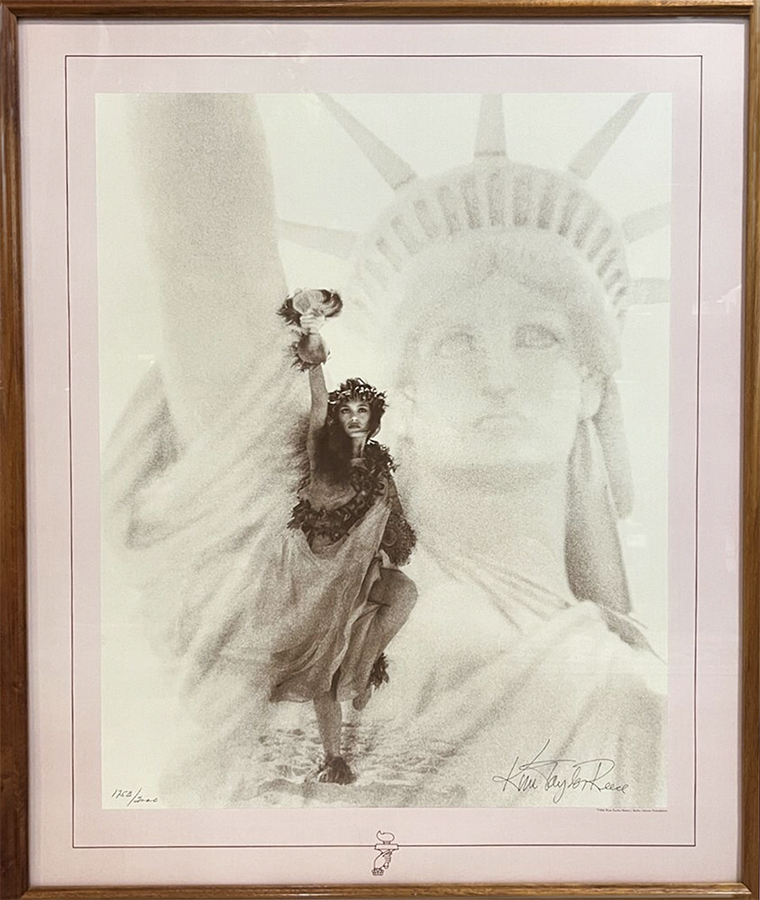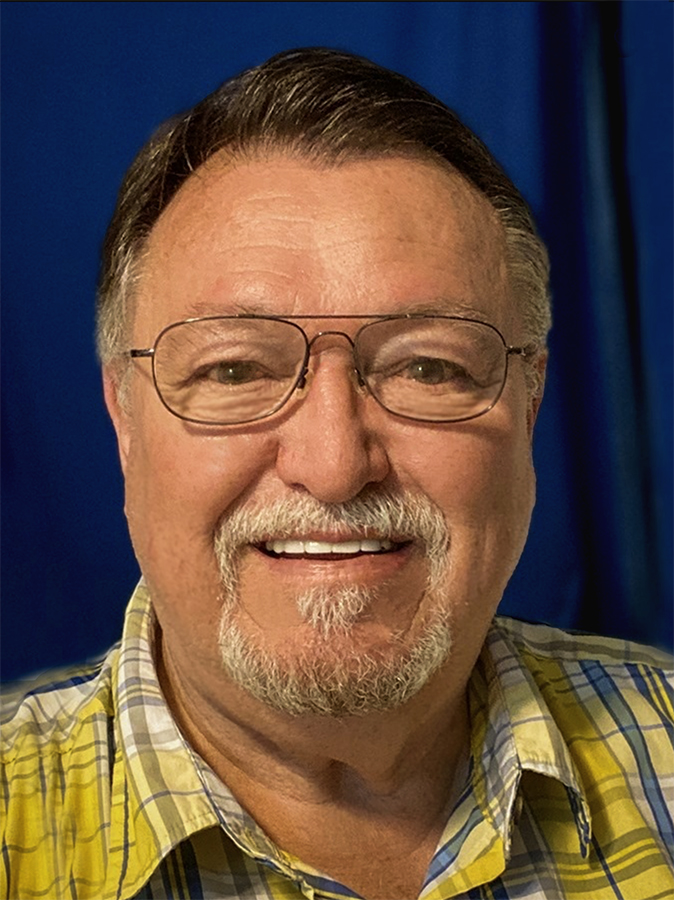[From an April 2, 2025, telephone interview with Reg Schwenke, formerly Polynesian Cultural Center vice president of communications. He currently lives in Puyallup, Washington.]
In 1985, as America prepared to celebrate the centennial of the Statue of Liberty the following year, a public service announcement on television inspired Reg Schwenke — then the Polynesian Cultural Centerʻs director of public relations — to contribute to the national effort by spearheading the creation of what would become well-known in Hawaii and beyond as the Aloha Liberty Foundation.
Inspired by a Statue of Liberty “plea”: Schwenke, a Samoan-born New Zealand citizen, said he saw a TV ad that encouraged people throughout America to contribute to a private $250 million fundraising effort “to help with the restoration of the Statue of Liberty and nearby Ellis Island Museum in New York City.”
“The commercial showed the rusting Statue of Liberty,” he said, with narration such as excerpts that American poet Emma Lazarus wrote in 1883 — …give me your tired, your poor… — to help raise money for the construction of the famous statue’s pedestal on Liberty Island. A few years earlier U.S. President Ronald Reagan had appointed Chrysler Corporation chairman Lee Iacocca to head the private committee that produced the commercial.
America, a meritocracy of opportunity: “It really hit me in my heart because here I was, a New Zealand citizen living in America, where I really believe I had more opportunities to succeed. I had worked professionally as a newspaper reporter and editor in different countries (New Zealand, Western & American Samoa, and Tahiti), and when I came to America, I always felt this was truly a land of opportunity — a true meritocracy where anyone could achieve whatever they desired if they worked hard enough for it. I was a beneficiary of that.”
“I thought, what if I could do something, even in my limited capacity, to raise funds out of Hawaii? Hawaii was then regarded as the gateway to America for all immigrants from Asia and the Pacific,” he continued.
The Aloha Liberty concept: Schwenke pondered the idea and decided to follow President Reagan’s example in Hawaii by recruiting interested business leaders and others to participate locally. He had met many of them as the first Samoan reporter for The Honolulu Advertiser and later with Pacific Business News.
Schwenke came up with the idea of forming a nonprofit foundation “to raise a quarter-million dollars in Hawaii, basically a grassroots campaign where every single cent, with nothing used for administration, would go to the national campaign.” He knew his idea would also generate more positive exposure for the Polynesian Cultural Center.
(On behalf of PCC, Schwenke had previously established the Sterling Scholar program, Hawaii’s most prestigious high school scholarship program that awarded $144,000 to the top seniors in 12 different subject categories. The final awards ceremony was televised throughout Hawaii.)
The Center sponsors the Aloha Liberty Foundation campaign: “I saw this as a great opportunity because the Polynesian Cultural Center is the embodiment of immigrants coming to America. We have all these foreign students who come here, mainly from the Pacific, and they’re given an opportunity to gain college and pay for their education by working at the Cultural Center and showcasing their own cultural heritage,” Schwenke said. “As a fellow Polynesian, this is something I was always very proud of. I just saw this whole thing as all being tied in together.
Schwenke approached then-PCC president, Ralph G. Rodgers Jr., who really liked the idea and approved it. Next, Reg enlisted Hawaii Governor George Ariyoshi and Honolulu Mayor Frank Fasi, who eagerly agreed to sign on as honorary co-chairmen of the Foundation. Bill Craig, the Honolulu director of the U.S. Immigration and Naturalization Services, and his regional commissioner, Harold Ezell, “also loved the idea and joined the ALF foundation board,” Reg said.
He further convinced James Koshiba, Esq., PCC’s attorney, who also loved the idea, to set up the nonprofit foundation and provide all legal services pro bono. The Center’s international advertising agency at the time, Ogilvy & Mather, also agreed to provide all design, advertising, and promotional work and materials pro bono and convinced some of their vendors (such as printers) to do likewise.
Uniting Hawaii’s Business Community: Under Reg’s leadership as the Founder and President of the Aloha Liberty Foundation, the initiative blossomed into what the national foundation executives in New York referred to as “the most successful grassroots campaign in America” — bringing together business leaders, government officials, artists, business executives, and everyday local citizens to honor Lady Liberty in a uniquely Hawaiian way.
____________________
“…national foundation executives in New York
referred to [the Aloha Liberty Foundation as
‘the most successful grassroots campaign in America’.”
____________________
“Liberty is not just an American ideal, it’s a universal one,” Schwenke often said, a sentiment that guided him as he rallied support among Hawaii’s most influential businesses and institutions across the state.
For example, Schwenke’s persuasive efforts led to major financial companies, including the Bank of Hawaii and First Hawaiian Bank to contribute $5,000 each. William Mendel Borthwick Jr., then president of Honolulu Federal Savings & Loan, went even further with a $50,000 cash donation and joined Ralph Rodgers Jr. as co-chairman of the foundation
“These corporations not only donated but also helped spread the campaign’s message throughout the islands, ensuring widespread participation,” Schwenke said.


Wyland and Kim Taylor Reece contributed artistic creations: Beyond financial support, Schwenke sought to make the campaign a cultural celebration. He enlisted renowned marine artist Wyland — mostly known for his large-scale maritime murals on the sides of buildings, including The Whaling Wall at the Cultural Center in the 1980s. Wyland created a beautiful original oil painting of the Statue of Liberty with a Hawaiian maile lei draped around her shoulders.
Wyland also agreed to hand-sign a limited edition of 100 numbered lithographs of his painting for the first 100 donors who contributed $1,000 or more to the ALF.
“His artwork captured the spirit of liberty through Hawaii’s natural beauty, merging patriotism with the islands’ deep artistic traditions.,” Schwenke said, noting the original 4×6-foot oil painting was donated to the Ellis Island Museum in New York harbor.
Additionally, famed Hawaii art photographer Kim Taylor Reece — who created a wave of very popular hula-themed photographic portraits of Hawaiian dancers in traditional garb — also produced a stunning Aloha Liberty photo-lithograph featuring then-Miss Hawaii Toni Costa in a Hawaiian outfit. Kim hand-signed and numbered 2,000 Aloha Liberty in the limited series of lithographs for all donors who contributed $20 or more to the ALF.
Both images became treasured symbols of Hawaii’s role in the national centennial celebration. “These artistic contributions elevated the campaign, drawing even more attention and participation from the community,” Schwenke said, noting that Kim Taylor Reece’s two original 4×6-foot photographs were donated respectively to Governor Ariyoshi and to the Ellis Island Museum in New York. After all of Reece’s 2,000 lithographs were presented, he destroyed the original negative.
Increasing public awareness with media support: Understanding the power of media, Schwenke ensured that Hawaii’s newspapers, radio stations, and television networks covered the campaign extensively. Public service announcements, feature articles, and interviews kept the momentum going, making the Aloha Liberty Foundation a household name.
“The more people knew, the more they wanted to be part of it,” Schwenke explained. The campaign soon became a source of statewide pride, with residents eager to contribute in any way they could.
Hue Cao’s inspiring essay contest story goes global: To ensure broad-based support and interest from Hawaii’s children, Schwenke enlisted the support of Francis Tananaka, then-Hawaii State Department of Education (DOE) superintendent. The DOE led perhaps one of the most poignant aspects of the campaign by inviting 5th to 8th graders across Hawaii to express what liberty meant to them in a statewide 250-word essay contest.
Eleven-year-old Hue Cao won the essay contest by describing how her mother and siblings had escaped communist Vietnam in search of a better life. She wrote how her mother had risked everything to flee Vietnam, enduring harrowing conditions, to give her children a future in the United States. Their journey reflected the very essence of what the Statue of Liberty symbolized — hope, freedom, and new beginnings.
“Hue Cao also wrote about her gratitude for the opportunities America had given her family,” Schwenke continued. “She eloquently described Lady Liberty as a beacon of hope for those escaping oppression, much like her own family had. Her words resonated deeply, not only within Hawaii but across the nation.”
Schwenke enlists President Reagan’s help: Hue won the grand prize of a brand-new Nissan Sentra car, but after the media exposure of her patriotic effort reached the mainland, her mother received an alarming letter several weeks later:
“The federal government wrote that the car Hue won for her mother meant the family would likely lose the welfare benefits her solo mother depended on to support Hue and her siblings,” Schwenke explained.
He rushed a lengthy telex directly to President Reagan at the White pleading for humanitarian relief, outlining Hue’s heartfelt expressions of freedom and liberty she and her family had experienced could suddenly turn into the cause of major financial loss for the family.
“Within a day, Hue’s mother received a call from a federal official confirming the White House had interceded,” Schwenke said. The official recommended that if the new Nissan vehicle Hue won was sold at auction and the proceeds set aside for a scholarship fund for Hue, her mother’s welfare benefits would not be impacted.
As he suspected, Schwenke said this entire episode with Hue became a national story. KSSK Radio with morning hosts Michael Perry and Larry Price provided live coverage of the auction at the local Nissan dealership, including the part where PCC president Ralph Rodgers made an opening bid of $12,500 (retail value of the car). “That turned out to be the only bid,” Schwenke said, adding that all other local TV stations recorded the event for news broadcasts that day.
Hue gets national recognition and presidential praise: As a result of the international media attention Hue’s essay received, Schwenke suggested — and national Statue of Liberty Foundation officials agreed — that Hue would be invited to read her essay on national TV during the Liberty Weekend festivities that would be carried around the world.
Then, days after Hue’s car was sold and her scholarship fund set up, Schwenke reached out to the White House again to inform them of a special press conference in Honolulu where she would express her heartfelt appreciation to President Reagan via the media.
Schwenke specifically mentioned the date and time of the press conference and extended an invitation for President Reagen to call into the event and talk with Hue Cao, if he wished to. The phone number was attached.
A White House spokesman said it was highly unlikely President Reagan would call because of his many pressing responsibilities. However, he ended with a slight ray of hope that it could happen.
‘Please stand-by for President Reagan’: Sure enough, about 30 minutes before the press conference began, a call from the White House switchboard came in confirming if this was where Hue’s press conference would be held. They reiterated, “No promises.” Meanwhile, local media assembled and were prepped.
“Exactly two minutes before the press conference began, the phone call came in,” Schwenke said, “and the White House operator calmly stated: ‘Please standby for President Ronald Reagan.’”
“What an unforgettable memory,” Schwenke added. “Hue’s story became a shining example of why the Statue of Liberty remains such a powerful symbol for immigrants. It was more than just a contest. It was a way to remind people why liberty matters. Hue’s victory was a testament to the campaign’s impact, bringing the human side of the centennial celebration to the forefront.”
Schwenke also noted that in those days the Polynesian Cultural Center used to subscribe to the national Burrelle’s clipping service that monitored newspaper coverage for its clients. “We literally got thousands of clippings from all over the world because of that story.”
Hawaii Liberty Weekend contingent gets ‘one more surprise’: With all the national publicity from Hue Cao’s essay, Schwenke said he contacted the national foundation committee, who invited a small group of people to attend the Liberty Weekend celebrations in New York City, where there would be one more surprise:
As part of the weekend plans, the national committee arranged for two people from each state to be sworn in as new U.S. citizens on Ellis Island for the first and only time by then-Chief Justice of the U.S. Supreme Court, Honorable Warren Berger. Hawaii’s designated new citizens would be transferred by the Coast Guard Admiral’s launch along with another famous new citizen, Russian dancer Mikhail Baryshnikov, who was performing at the main event on global TV.
Because Schwenke’s tireless dedication to the campaign did not go unnoticed, Hawaii Gov. George Ariyoshi selected him as one of the two-state candidates to participate in the citizenship event as a tribute to his Aloha Liberty Foundation efforts.
Schwenke said, “This moment was particularly meaningful,” as a New Zealand citizen and U.S. Permanent Resident who had spent years advocating for the ideals represented by the Statue of Liberty.
____________________
“It wasn’t just about the money we raised —
it was about uniting our community behind
something larger than ourselves.”
____________________
“The campaign had succeeded beyond expectations, both in financial contributions and in fostering a deeper connection to American values,” Schwenke added.
A Legacy of aloha and liberty: “The Aloha Liberty Foundation campaign was more than just a fundraising effort. “It was a movement that embodied Hawaii’s unique blend of cultural pride and national unity.”
Through his leadership, Reg Schwenke brought together businesses, artists, government leaders, and everyday citizens to celebrate freedom in a way that was distinctly Hawaiian.
His work ensured Hawaii’s voice was heard in the national centennial celebration, and his legacy lives on as a reminder of how one person’s vision can unite a community for a greater cause.
Lady Liberty stood tall in New York Harbor, but thanks to Schwenke and the people of Hawaii, her light shone just as brightly across the Pacific.
Months later, Schwenke received a personal invitation to meet and greet President Reagan and wife Nancy as they exited Air Force One on a brief stopover visit to Hawaii. He later received a copy of that photo signed by President Reagan.
“In this exceptional land of opportunity that is America, you can be and achieve whatever you are willing to work for in this great country. I’m living proof,” Schwenke concluded.
